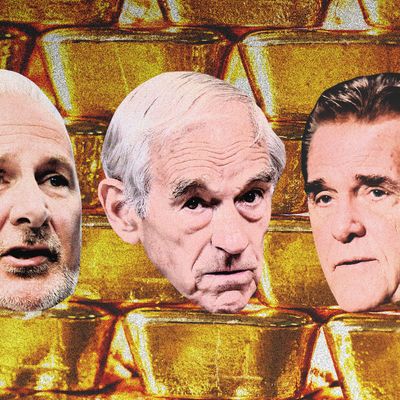
If anybody was going to get rich off inflation, it was supposed to be the goldbugs. For the last decade or so, these men have been warning about the dangers of rising prices to your cost of living and extolling gold’s special virtue for defeating that threat. “When our country used to flex its muscle with battleships like the USS Iowa, the world would listen,” said William Devane, a former daytime-TV actor, in a television commercial where he was dressed in a leather bomber jacket and aviators in front of battleship turrets. “There are dangerous forces pulling our country apart, threatening our economy and our way of life. That’s why I’m going to do two things: support our military, and buy gold from Rosland Capital.” For the goldbug, the metal isn’t just an asset: It’s a way of life, nearly a religion, a rebellion against the last 50 or so years of Federal Reserve supremacy over the U.S. markets, a way to show that — when it all falls apart and our dollars are no better than toilet paper — they’ll be the last ones laughing.
Now, however, may be the twilight of the goldbugs. On Wednesday, the federal government published its consumer price index for October, showing the highest annual rate of inflation in 30 years, with everything from gas to food to rent taking up a bigger share of every paycheck. Anybody familiar with the logic of the bullion advertisements might reasonably expect the gold market to be red hot right now. But that is far from the case, with gold underperforming most major assets in U.S. markets. Year to date, it’s more or less flat, while the other commodities are up massively for the year:
While the sheeple who invested in the S&P 500 stock index are up 24 percent year to date, the poor souls who put money into a fund run by prominent gold investor Peter Schiff are down 11 percent.
The blockbuster print of 6.2 percent inflation sent the price of gold up marginally — one percent to $1,848 by the end of Wednesday. But an ounce of gold is still worth $40 less than it was in June, when the economy was only starting to heat up, and even farther below its peak above $2,000 last summer. Goldbugs who pictured this day for years — 6 percent inflation! — must have imagined it as a moment for claiming victory and marveling at their profits. But financial reality hasn’t been so simple.
Gold had been the asset of choice for those suspicious of the U.S. dollar (a.k.a. our “fiat” currency) since August 15, 1971, when President Richard Nixon announced the end of the gold standard, when the value of the dollar was pegged to a fixed price of gold, ushering in an era of central-bank-driven monetary policy. Inflation shocks in the 1970s sent the price of the metal up, cementing its status in Wall Street’s playbook — and the public imagination — as a way to keep wealth from degrading when the price of everything else was rising.
Devane is merely one of the retiring generation’s celebrities who hawk the metal. People like Chuck Woolery, the original host of Wheel of Fortune, and former Texas representative and Republican presidential hopeful Ron Paul push the commodity in low-budget spots filled with scary charts and alarming pictures of Washington, D.C. Fox Business host Stuart Varney seems to be the most gold-friendly of the news hosts, or at least the happiest to bring on goldbugs to his show. Recently, Paul — whose book End the Fed argues for abolishing the central bank and returning to the gold standard — took to a YouTube channel to suggest that a shadowy cabal of government agencies collude to keep gold prices contained in order to prevent a market panic.
The goldbugs were not cheery this week. On his syndicated radio show, Woolery lamented about hyperinflation and the march of socialism. Varney brought on a guest to talk about how gold has “gained ground,” even though the chart next to him showed it was up less than one percent. (The guest also hinted that gold was too expensive). Paul, for his part, stayed silent, preferring to rail against vaccine mandates on his Twitter account.
What accounts for this sorry state of events? The most popular theory right now in financial circles is that goldbugs have underestimated the competitive appeal of cryptocurrencies. Bitcoin, prized by libertarians and Occupy Wall Streeters alike for circumventing government control, has many of the same attributes as gold but without the need for vaults, jewelers, or physical mining operations. There’s even a growing split between the new-guard crypto investors, memeing their way into riches, and the goldbugs who appear to be dropping off the investment map.
On the surface, bitcoin, barely a decade old, and gold, used from the dawn of civilization, shouldn’t have much in common with each other. But look closely, and there is a broad overlap. Like the gold supply that is limited by how much of the metal can be mined in a given year, the number of bitcoin in the world is fixed into the code of the currency, making its scarcity part of what makes it so valuable. That narrative about digital scarcity is among the key reasons bitcoin hit an all-time high above $68,000 earlier this week. It’s also just a hot investment that’s captured the ineffable momentum of the markets. “One reason [gold has lagged] is that many investors are interested in an alternative to gold — and they see that alternative being cryptocurrency,” Duke University professor Campbell Harvey, who’s written about the tenuous relationship between gold and short-term inflation, told Intelligencer. “Another possibility is that the gold price, in my calculation, is actually pretty expensive and unattractive, given its history.”
Goldbugs now seem to be stuck with a bad hand, making arguments full of contradictions with no clear thesis. Juan Carlos Artigas, head of research at the World Gold Council, told me there is still room for the metal to become more valuable, but also that the effects of inflation are “priced in,” meaning that they were expected. He told me that gold is a hedge if the economy turns and can become more valuable when consumption picks up. But now that inflation is here, goldbugs don’t really have to worry about the price going up or down — not when there are still sponsorship deals to be had for daytime-television commercials. Those gold coins just aren’t going to sell themselves.






























